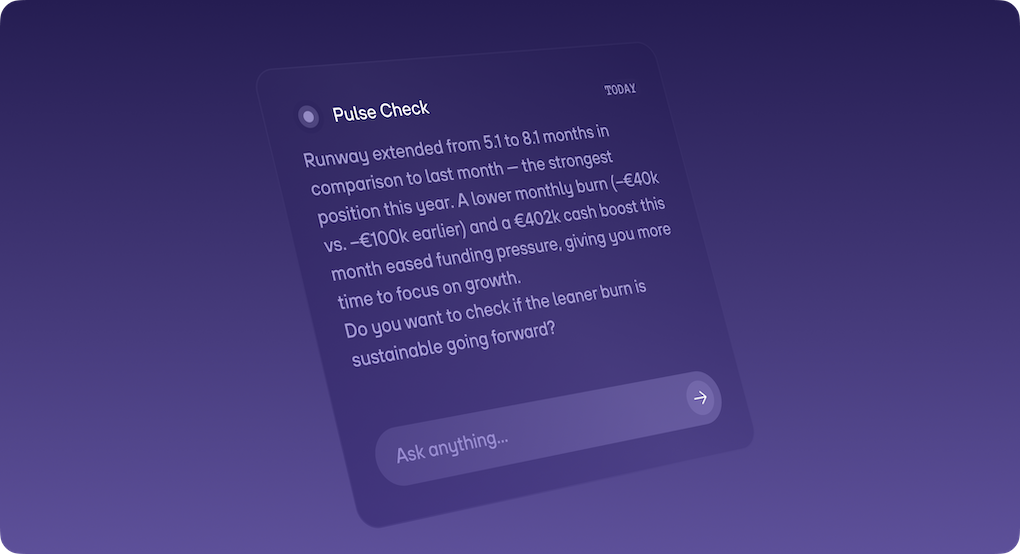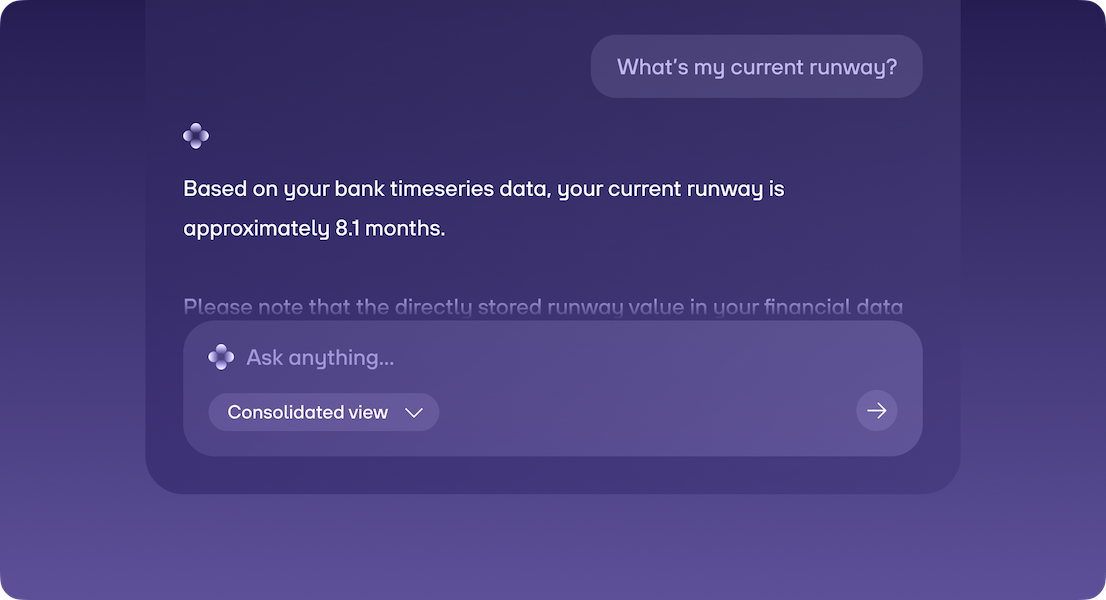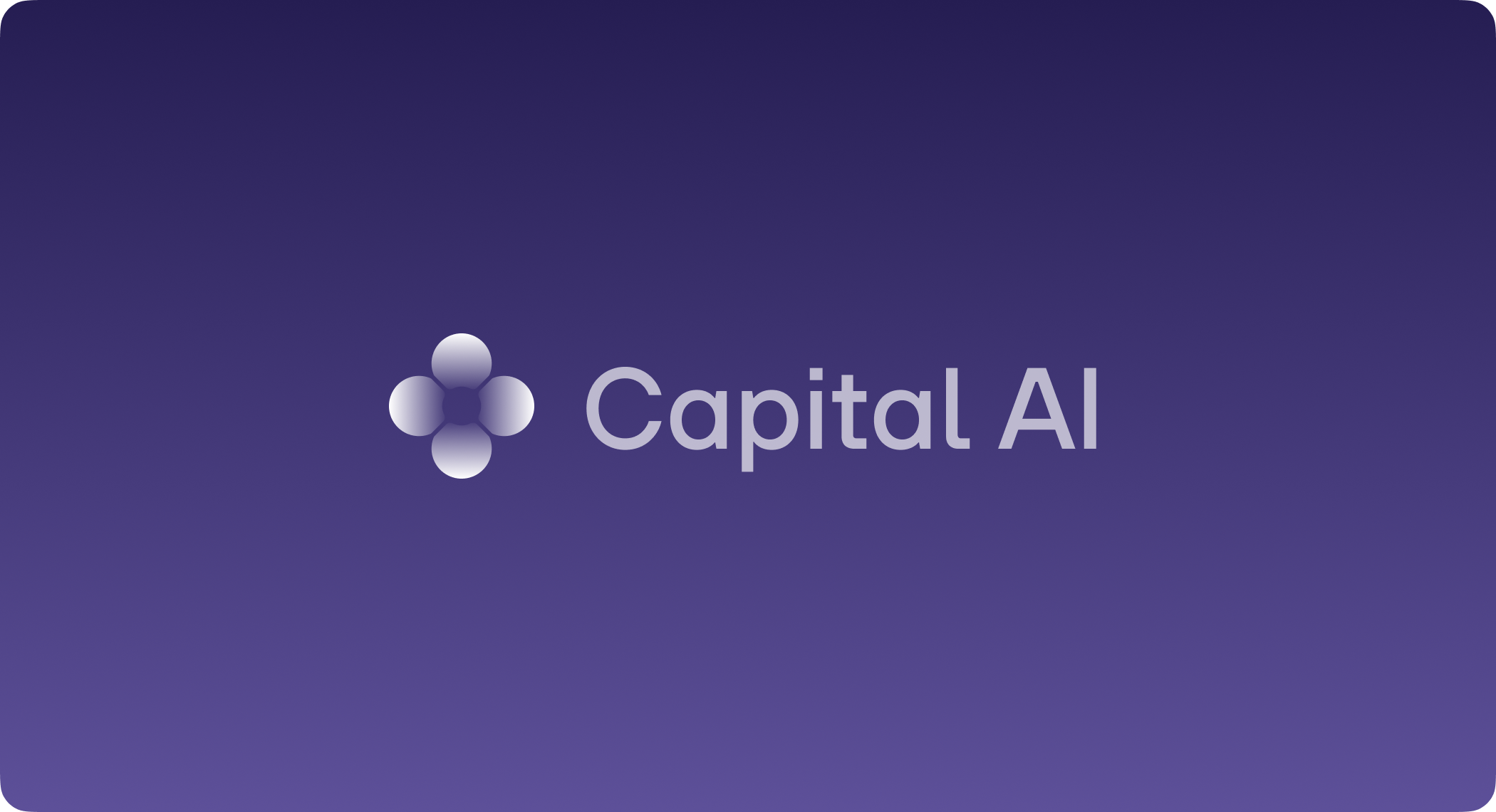Think of Capital AI as your financial sparring partner. It’s part CFO, part analyst and always watching your numbers. It helps you understand what's happening in your finances, why it's happening, and what to do about it.
You don’t need to manually hunt through spreadsheets and dashboards. You don’t need to wonder if you missed something critical about your company.
TL;DR
- Pulse Check delivers daily insights automatically. Capital AI surfaces critical patterns, deviations, and unusual transactions before you even ask, so you always know what needs your attention.
- Chat answers any financial question in plain language. Ask about burn, runway, cost drivers, or plan variances. Get instant analysis grounded in your actual bank, ERP, and business plan data.
- From reactive dashboards to proactive intelligence. Stop hunting through spreadsheets. Capital AI connects the dots across your financial data to reveal patterns and spot deviations.
Four ways to use Capital AI
1. Quick reports and summaries
Get instant analysis on specific topics without building custom reports. Ask for month-to-date cash performance compared to your three-month average, and Capital AI delivers the full breakdown: net performance, inflow changes, outflow trends, completed by percentages and context.
Prompt: Compare my month-to-date cash performance to the last three months.
2. Deviation analysis
Compare your actuals against your business plan to see where you're off track. Capital AI can reveal that you're at X% of your customer target with a €X lower cash balance than expected. It instantly shows you where the gap is and why.
Prompt: Show me how my current performance compares to my business plan. Break down revenue vs target and cash balance variance.
3. Data quality checks
Spot tagging issues and data inconsistencies. Capital AI can identify wrongly tagged intercompany transactions and provide specific bank transaction details so you can correct them immediately.
Prompt: Check my transactions for tagging errors. Are there any intercompany transactions that are tagged incorrectly? If yes, please search for a corresponding matching transaction for each unmatched transfer.
4. Custom analysis on demand
Need insights that don't exist in your dashboard yet? Ask Capital AI to create custom analysis, like an accounts receivable breakdown showing €X in open, overdue, and delinquent invoices, without waiting for front-end development. Just connect your revenue data to get the insights.
Prompt: Analyze my accounts receivable. How much is open, overdue, and delinquent? Break it down by customer if possible.
If you're looking for prompts to start: we've compiled a list of 10 prompts to get you started with Capital AI.
Now, let me show you how it works.
Get CFO-grade clarity on your financials
Grounded in your financial data. Capital AI tells you what needs your attention. It answers when you ask why. And it delivers a plan you can execute on.
Try it outPulse Check: your daily financial briefing

Every day, Capital AI analyzes your financials and delivers a short, powerful narrative about what moved, why it happened, and whether it matters. You get this automatically. There is no setup required and no need to ask questions.
What you get: Like a note from your CFO
A daily email (or weekly, if you prefer) that lands in your inbox and appears on your Capital OS dashboard. It reads like a note from your CFO: clear, contextual, and focused on what actually matters.
The Pulse Check looks at:
- Your closing cash balance and total cash flow vs. yesterday
- Month-to-date cash inflows and outflows
- Your current runway and any material changes
- Unusual or large transactions that need attention
- New costs or patterns that could signal a shift
How it helps: Telling you what to focus on
Instead of scanning reports to figure out what changed, you open one message and immediately know: Did something important happen? Should I dig deeper?
This helps guide your attention – without you digging in spreadsheets. Because finding patterns in the data and spotting deviations can be super hard. Capital AI does this for you and delivers it with the Pulse Check at your fingertips.
An example
Let's say Capital AI detects an unusual pattern in your marketing performance. Your marketing efficiency dropped sharply and your revenue-to-spend ratio fell from 3.08 to 1.90 over the last four months of 2024.
Capital AI can flags it automatically in your Pulse Check:
“Your marketing efficiency dropped sharply in the last four months of 2024. Your revenue-to-spend ratio fell from 3.08 (January-August) to 1.90 (September-December). This decline was a direct result of a strategic shift in your marketing spend.”
That's it. A clear nudge that something shifted and might need your attention. You didn't have to spot the pattern yourself. You didn't have to calculate the ratios. Capital AI surfaced it and explained what happened.
Going deeper
However, if you want to dig deeper you can directly ask questions about the Pulse Check findings. This is where the chat comes into play.
Chat: Your on-demand financial analyst

The Pulse Check tells you what's happening and guides your attention. The chat lets you dig deeper, test scenarios, and get answers that are grounded in your financial data.
What you can ask
Capital AI can answer virtually any question about your finances. Here are some of the most common questions:
Understanding your current state
- What's our current monthly burn?
- What is my current runway?
- What is the cash revenue since 2025?
- What was my revenue in Q2? Did it increase or decrease?
Spotting trends and drivers
- Did my runway improve this year?
- How did my burn rate develop over the last three months? Explain the driving forces.
- What was the biggest cost block in Q2 2025?
- What are the biggest drivers in my IT costs in the last months?
- How did my current burn develop? Compare last month against the previous two months.
Comparing against your plan
- How did my cash balance this year develop compared to my business plan?
- How did my revenue from invoices and my cash balance develop against my business plan in July?
Growth analysis
- What is my average monthly YoY revenue growth rate based on cash data?
- How did my runway develop this year and what is the most important driver for the trend?
Finding what needs attention
- Do I have big bank transactions which are worth paying attention to?
An example
After the Pulse Check flagged the efficiency drop, you decide to dig deeper. You're currently evaluating a US expansion and need to understand what's driving the decline and how much funding you'll need.
You open the chat and ask:
“Why did marketing efficiency decline so much in the last four months of 2024? How much funding should I secure for a US expansion?”
Capital AI analyzes your data and responds:
“Your marketing efficiency dropped sharply in the last four months of 2024. Your revenue-to-spend ratio fell from 3.8 (from €620k to €890k) to 1.9 (from €890k to €1.2M). This decline was a direct result of you significantly increasing your total marketing spend from €650,000 in the first eight months to €980,000 in the last four months. You shifted away from your most efficient channel, Facebook, where you spent €520k in the first eight months. Instead, you poured €380k into Google Ads in the last four months, a new and less efficient channel. LinkedIn spend also nearly doubled from €95k to €210k in these periods, and you explored other new channels like YouTube and Instagram Ads. Expanding into a new market like the US would mean replicating this growth strategy, but in an unfamiliar environment. If your current marketing efforts are already becoming less efficient, scaling them up in a new territory could quickly become very expensive and dilute your returns further. For your US expansion, you should budget for a period of similar low efficiency. Entering a new market often means higher initial costs to acquire customers, much like what you saw in Q4 2024.”
Then it gives you a concrete funding recommendation based on three scenarios:
- Realistic Case (1.9 efficiency): ~€1.8M
- Conservative Case (1.3 efficiency): ~€2.4M
- Optimistic Case (3.8 efficiency): ~€1.1M
You get the full picture: why efficiency dropped, what you should expect in a new market, and exactly how much to raise. All grounded in your historical performance data.
How it works: Connecting all your financial data
Every answer Capital AI gives you is based on your connected financial data: cash flow, invoices, revenue, business plan. It doesn't make generic suggestions. It analyzes your specific numbers, connects patterns across sources, and explains its reasoning in plain language.
You can keep asking follow-up questions to go as deep as you need:
- "What happens if I cut Google Ads spend by 20%?"
- "Show me a side-by-side forecast with different efficiency assumptions."
- "How did my runway develop this month compared to the last two?"
Capital AI stays in context and builds on previous answers, so the conversation flows naturally.
The bottom line
Capital AI works in two modes:
- Proactive (Pulse Check): Surfaces what matters before you even ask. Shows up daily with the critical insight you need to know.
- On-demand (Chat): Answers any question about your finances in plain language. Digs into root causes, runs scenarios, and gives you executable guidance.
Together, they replace hours of dashboard hunting and spreadsheet analysis with instant clarity and confidence. You spend less time translating data and more time making decisions.
Q&A: How to use Capital AI
What is Capital AI?
A financial sparring partner inside Capital OS that explains what’s happening in your finances, why it’s happening, and what to do next—without manual dashboard hunting.
How does Capital AI work at a high level?
It connects cash flow, invoices, revenue, and your business plan; monitors changes; flags what matters; and delivers explanations plus executable next steps.
What are the two ways of using Capital AI?
Proactive (Pulse Check): automatic daily/weekly briefings. On-demand (Chat): ask any question in natural language and get analysis, scenarios, and action plans.
What is the Pulse Check and why does it matter?
A daily/weekly briefing (delivered via email and shown in Capital OS) that tells you what changed, why it changed, and whether it matters. It automatically analyzes closing cash and cash flow vs. yesterday, month-to-date inflows/outflows, runway shifts, unusual or large transactions, and emerging cost patterns. The result: you know exactly where to focus without scanning reports.
What is the Chat, what can I ask, and how does it handle follow-ups?
Your on-demand financial analyst. Ask any plain-language question and get analysis, scenarios, and next steps. It covers:
- Current state & trends (“What’s our monthly burn?” “How did burn change over the last three months and why?”)
- Plan vs. actuals (“Show revenue vs. target and cash balance variance vs. plan.”)
- Growth & attention areas (“What’s my average monthly YoY revenue growth (cash-based)?” “Any large bank transactions worth attention?”)
- Scenario tests (“Cut Google Ads by 20%. What's the impact?” “Compare side-by-side forecasts with different efficiency assumptions.”)
The chat stays in context, builds on previous answers, and returns summaries plus actionable recommendations.
Get CFO-grade clarity on your financials
Grounded in your financial data. Capital AI tells you what needs your attention. It answers when you ask why. And it delivers a plan you can execute on.
Try it out

.gif)







